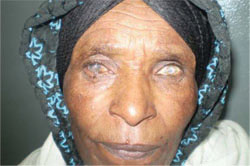5.4 Trachoma
Trachoma is described in detail in the Communicable Diseases Module, Part 4, Study Session 39.
We will briefly mention a very common cause of blindness in Ethiopia – bacterial infection with Chlamydia trachomatis leading to a condition called trachoma. The infection causes inflammation of the conjunctiva, the thin transparent membrane covering the eyeball and the inner surface of the eyelids. The upper eyelid is particularly affected and over time it becomes so swollen and scarred that the eyelashes turn inwards and scratch across the surface of the cornea every time the person blinks. The cornea is damaged by the scratching eyelashes and it gradually becomes opaque (unable to transmit light).
Corneal opacity is a major cause of sight loss. Over 80 million people suffer from trachoma worldwide, and in Ethiopia there are estimated to be more than 238,000 people who are blind because of it (Figure 5.9).

Mild trachoma is easily treated with tetracycline eye ointment (1%). Trachoma scarring can be reduced or prevented by simple eye surgery to turn the eyelashes outwards so they don’t scratch the eye. Prevention of trachoma is through avoiding the infections from getting into the eyes. The bacteria are transmitted mainly by flies landing on the face and carrying the infected discharge from the eyes to another person, or the bacteria are transferred on dirty hands or cloths used to wipe the sore eyes. Regular washing of faces and hands, disposing of rubbish and other waste to keep flies away from houses, and penning animals away from homes at night, are all ways to reduce the risk of trachoma.
Next you will be studying about foreign bodies in the ear, which is a common problem in children.
5.3.2 Supportive care in the case of eye injury
